
by Dhugal Lindsay, Japan Agency for Marine-Earth Science and Technology
July 26, 2017
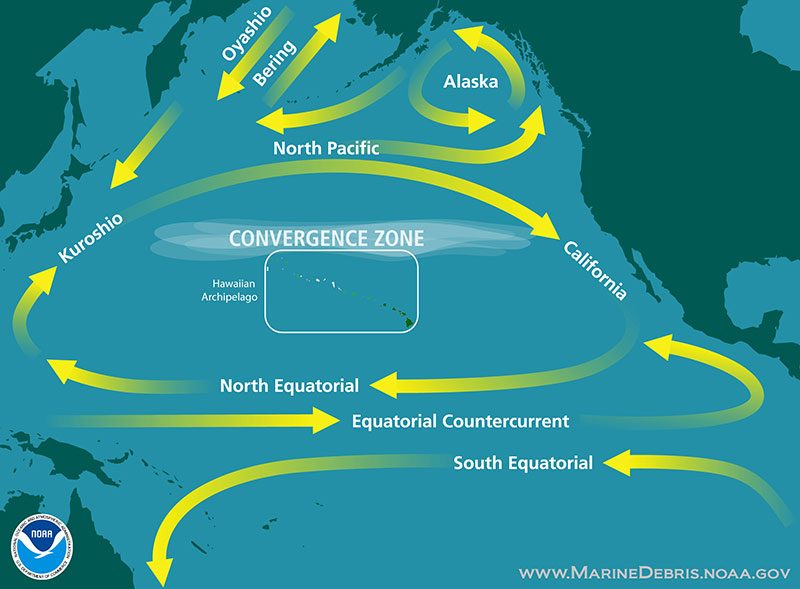
The North Pacific Gyre, located in the northern Pacific Ocean, is one of five major oceanic gyres and covers most of the northern Pacific Ocean. It is Earth’s largest ecosystem, approximately 20 million square kilometers (over 7.7 billion square miles). The gyre’s circulation pattern is clockwise, as it is in the Northern Hemisphere. This region collects an unusually high amount of human-made marine debris; it is also called the Great Pacific Garbage Patch. Image courtesy of NOAA’s Marine Debris Program. Download larger version (jpg, 1.0 MB).
The central part of the North Pacific Ocean, the North Pacific Gyre, contains a vast expanse of water with low food concentrations. This is because the area is capped by a warm, relatively still layer of surface water. This warm-water lens stops nutrients from being upwelled into the sunlit zone and providing nourishment for the phyto- (plant) plankton.
With water temperatures rising at the ocean’s surface over the last several decades, these oligotrophic (low food) “ocean desert” areas have been expanding. The evidence for this is in the maps of phytoplankton chlorophyll concentrations captured by satellites. Phytoplankton that can capture and “fix” atmospheric nitrogen dominate in these regions, and these plant cells are usually smaller than those that flourish in high-productivity areas.
Several groups of zoo- (animal) plankton have evolved to excel at feeding on these small cells. It is no surprise that these are also the groups we seem to be finding in the highest abundances in the deep waters below these “ocean deserts.”
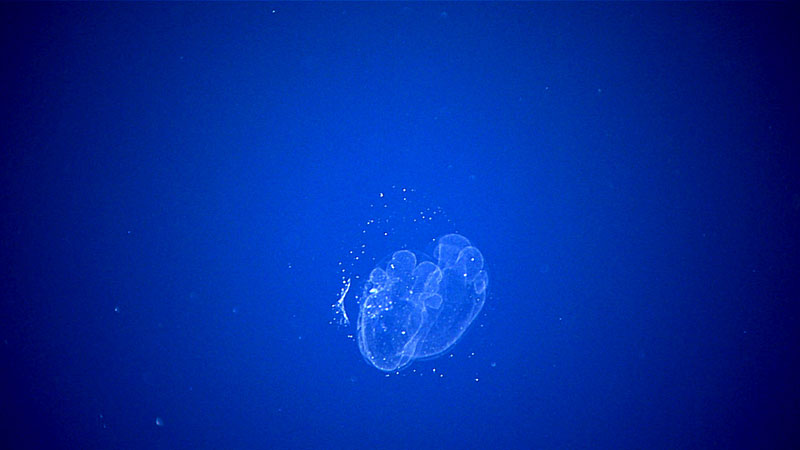
This is a larvacean, or sea tadpole, “house.” The diffuse outer filter catches the larger particles that would be too big to fit in the larvacean’s mouth and protects the inner filter, which is used to strain food particles from the water. The larvacean lives nested inside this inner filter and produces a current by beating its tail. This current both keeps the house inflated and moves water through the filter of the house. The two-lobed structure of the inner filter and the bumpiness or sub-lobes suggest this may be a species of Mesochordeus. Image courtesy of the NOAA Office of Ocean Exploration and Research, 2017 Laulima O Ka Moana. Download larger version (jpg, 1.1 MB).
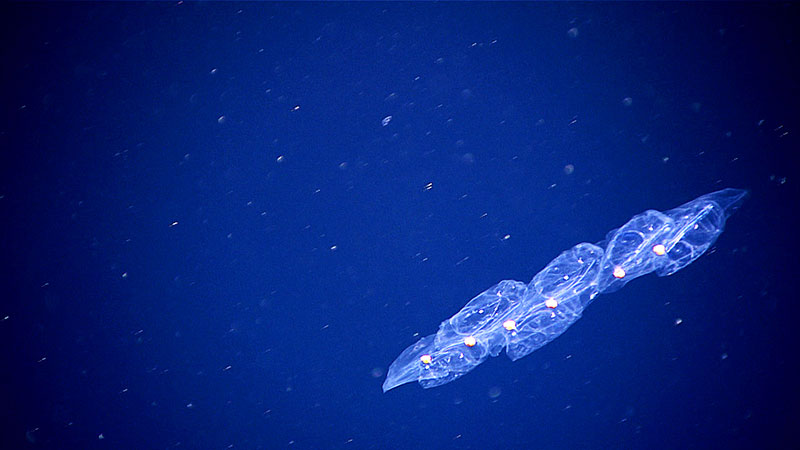
The rounded, pigmented guts of these salps are clearly visible in the individual salps in this chain. The way these asexual zooids are attached to each other gives hints as to the genus. If the zooids are arranged in a circle, then the genus is probably Cyclosalpa; as a helix it is probably Helicosalpa. The exact number of muscle bands and where, or if, the bands merged with one another are important taxonomic characters to tell salp species apart. The present species could well belong to the genus Salpa. Image courtesy of the NOAA Office of Ocean Exploration and Research, 2017 Laulima O Ka Moana. Download larger version (jpg, 1.3 MB).
One such group of zooplankton is the pelagic tunicates, or sea squirts. These animals are gelatinous in consistency and filter small particles out of the water very efficiently. The larvaceans , or sea tadpoles, look just like their namesake, with a rounded “head” (actually the body with all the internal organs) and a long, flattened tail. Larvaceans can fashion mucous “houses” by excreting a woven net of cellulose strands from a gland below their mouths. They puff up or expand these houses through the beating action of their tail and the houses have a double-layered structure with a fine-meshed inner house and a coarse-meshed outer house. The outer house keeps out particles that are too big for the larvacean to ingest while the particles the animal eats are concentrated on the mesh of the inner house.
When the filters become clogged, the larvacean bails out of its house and quickly expands a new one that it keeps in reserve so that it can continually feed. One can tell the taxonomic group that a larvacean belongs to by the structure of their houses, so presumably each house is good at catching different subsets of the particulate environment.
Another type of pelagic tunicate is the salp, which looks like a swimming tube of jelly. As the tube expands, it fills with water. With a flex of its muscles, the salp will contract its tubular body, expelling the water through its rear end and propelling it through the ocean. Salps also have a feeding mesh that strains the food particles from the water they intake in order to propel themselves. After these particles are digested, they are expelled as fecal pellets that sink rapidly towards the deep ocean. These pellets and the clogged and discarded houses of larvaceans provide a large amount of the food exported from the sunlit surface layers into the dark depths of the deep sea below these ocean deserts.
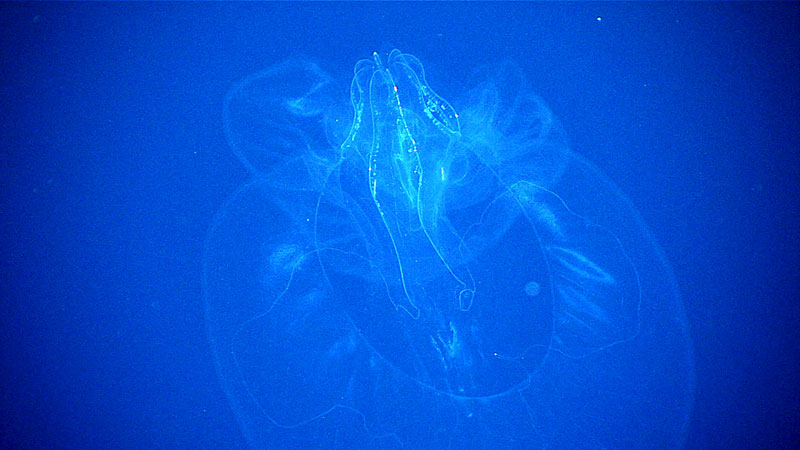
This lobate ctenophore, or comb jelly, is so fragile that it has never been successfully captured in one piece, giving it its nickname, sarcastically, of “Intacta.” Image courtesy of the NOAA Office of Ocean Exploration and Research, 2017 Laulima O Ka Moana. Download larger version (jpg, 1.7 MB).
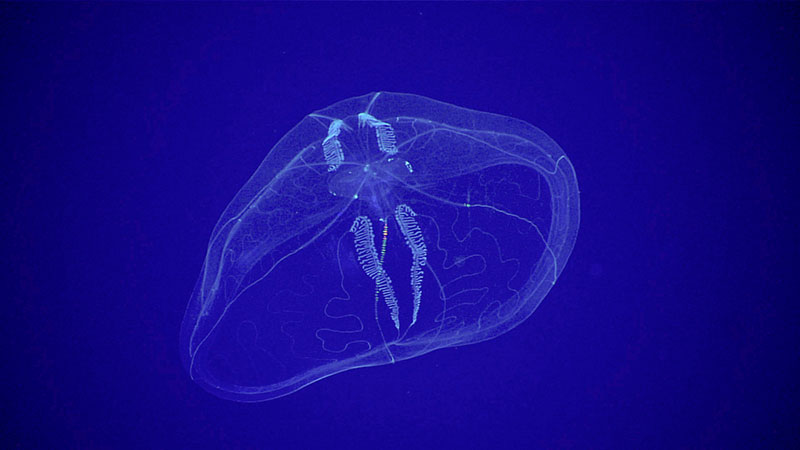
This ctenophore, or comb jelly, belongs to the genus Thalassocalyce. Only one species is currently described and the present species is either a mature form of that species, Thalassocalyce inconstans, or it is a new deeper-living species. The white bands that occur in pairs are the gonads of the animal and their resemblance to eyes when the hemispherical, medusoid body is viewed from above lend it its common Japanese name of the “mask jelly.” Image courtesy of the NOAA Office of Ocean Exploration and Research, 2017 Laulima O Ka Moana. Download larger version (jpg, 973 KB).
Yet another zooplankton group that does well in these low food conditions is the ctenophores, or comb jellies. These animals have gelatinous bodies that can be up to 98 percent water and swim through the water using rows of cilia that function like little boat paddles. These cilia catch the light from the remotely operated vehicle and reflect it back in a rainbow of colour.
The lobate ctenophores, in particular, are very good at catching particles of all sorts. They use sticky cells on the fleshy oral lobes that project from either side of their mouths. Some ctenophores float in the water with their lobes open in the form of a funnel. This causes sinking particles to be channeled towards their mouths.
The great ocean gyres have recently been gathering attention because of the large amounts of plastic waste that get concentrated in their centers due to their whirlpool nature. Much attention has gone to the animals we can see that have been visibly impacted by these plastics, like seabirds and reptiles such as turtles, that can choke and die on plastic bags.
A lot of this plastic, though, has been broken up by the sun, wind, and waves into much smaller particles known as microplastics. As our filter-feeding friends of the ocean deserts happily strain tiny particles out of the water in order to feed and survive, the percentage of these particles that are plastic rather than organic becomes important in the net sum of how much energy needs to be expended for a given intake of energy in the form of food. Once more energy is used in the filtering process than can be gained from the ingested particles, the animals have a reduced ability to survive.
At present, there is no information available on the state of microplastics with respect to filter feeders in the open ocean. One thing is certain, though: Just as many deep-sea animals recycle the carbon and energy contained in the sinking houses of larvaceans and the poop of salps when they feed, we should also be recycling more of our plastics!